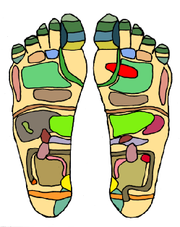 |
|
An
example of a reflexology chart, demonstrating the
areas of the feet that practitioners believe correspond
with organs in the "zones" of the body. |
Reflexology,
or zone therapy, is the practice of massaging,
squeezing, or pushing on parts of the feet, or sometimes
the hands and ears, with the goal of encouraging a beneficial
effect on other parts of the body, or to improve general
health.
There is
no consensus on how reflexology does or could work in practice;
a unifying theme is the idea that areas on the foot correspond
to areas of the body, and that by manipulating these one can
improve health through one's qi.[1]
Concerns
have been raised by medical professionals that treating potentially
serious illnesses with reflexology, which has no proven efficacy,
could delay the seeking of help from proven conventional medicine.[2]
Claimed
mechanisms of operation
Reflexologists
posit that the body contains an energy field, invisible life
force, or Qi, the blockage of which can prevent healing.[1]
Other reflexologists
claim to be able to relieve stress and pain in other parts of
the body through the manipulation of the feet.[3]
Other proposed
effects of reflexology include the release of endorphins (natural
pain killers found in the body), the promotion of lymphatic
flow in the body or the dissolving of uric acid crystals.
These hypotheses
are rejected by the general medical community, citing a lack
of scientific evidence and the well-tested germ theory of disease.[4]
History
The precursor
of modern reflexology was introduced to the United States in
1913 by William H. Fitzgerald, M.D. (1872-1942), an ear, nose,
and throat specialist, and Dr. Edwin Bowers. Fitzgerald claimed
that applying pressure had an anesthetic effect on other areas
of the body.[5]
Reflexology
was further developed by Eunice D. Ingham (1899-1974), a nurse
and physiotherapist, in the 1930s and 1940s.[6][7] Ingham claimed that the feet and hands
were especially sensitive, and mapped the entire body into "reflexes"
on the feet. It was at this time that "zone therapy" was renamed
reflexology.
Modern reflexologists
in the United States and the United Kingdom often learn Ingham's
method first, although there are other more recently developed
methods.[4]
Criticism
Common criticisms
of reflexology are the lack of central regulation, accreditation
and licensing, the lack of medical training provided to reflexologists,
and the short duration of training programmes. Diplomas in reflexology
can be attained with as little as six months of home study;[8] and the lack of licensing and regulation
allows anyone to practice as a reflexologist with no qualifications.
Reflexology's
claim to manipulate energy (Qi) has been called pseudoscientific
as there is no scientific evidence for the existence of life
energy, Qi, 'crystalline structures' or 'pathways' in the body.[9]
Reflexology
charts
A reflexology
chart shows the "reflex zones" worked by reflexologists on the
soles of the feet. Similar maps exist for the position of the
reflexes on the hands and ears.
In this
chart, the color codes represent the following organs or parts
of the body:
|
|
|
Brain |
|
Stomach |
| |
Sinuses |
|
Spleen |
| |
Voice |
|
Liver |
| |
Pituitary gland |
|
Gall Bladder |
| |
Neck and Throat |
|
Adrenal Gland |
| |
Eyes |
|
Pancreas |
| |
Ears |
|
Kidney |
| |
Armpit |
|
Ureter |
| |
Shoulder and Arm |
|
Bladder |
| |
Lung and Breast |
|
Colon |
| |
Heart |
|
Small Intestine |
| |
Thyroid and Bronchial |
|
Coccyx |
| |
Solar Plexus |
|
Sciatic Nerve |
| |
Diaphragm |
|
Peyer's Patches |
| |
Appendix |
|
Reflexology
in the Media
An episode
of Penn & Teller:
Bullshit! (1-02 Alternative
Medicine) focused on reflexology. The original airing was
February 7,
2003.
The
Real Hustle mentioned reflexology as part of a weight loss
scam (Season 4 Episode 2).
Notes
- Norman,
Laura; Thomas Cowan (1989). The Reflexology Handbook,
A Complete Guide. Piatkus,
22, 23.
- Reflexology (html) (english). National Council Against Health Fraud
(1996).
-
What is Reflexology?
(html) (english).
- Natural Standard. Harvard Medical School (July 7, 2005).
- Norman,
Laura; Thomas Cowan (1989). The Reflexology Handbook,
A Complete Guide. Piatkus,
17.
-
Benjamin, Patricia (1989).
"Eunice D. Ingham and the development of foot reflexology
in the U.S.". American Massage Therapy Journal.
-
Massagenerd.com Presents History of Massage, Therapies & Rules
(pdf) (english).
- The Open
College reflexology diploma course (html) (english).
-
Barrett, Stephen (2004-09-25). Reflexology: A close look. Quackwatch.
External
links
Professional
bodies and organisations
|

